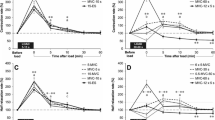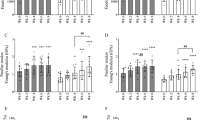Abstract
Purpose
This study aimed to investigate conditioning effects from a single 6-s plantar flexion maximal voluntary isometric contraction (MVIC) on Achilles tendon stiffness (ATS) and twitch properties of the triceps surae in athletes.
Methods
Peak twitch (PT), rate of torque development (RTD), rising time (RT10–90%) and half relaxation time (HRT) were measured from supramaximal twitches evoked in the plantar flexors of 10 highly trained athletes. Twitches were evoked before and at seven occasions during 10 min of recovery after a 6-s MVIC. In a second session, but at identical post-conditioning time points, ATS was measured at 30 and 50 % of MVIC (ATS30% and ATS50%) using an ultrasonography-based method.
Results
The magnitude and duration of the conditioning MVIC on muscle contractile properties were in accordance with previous literature on post activation potentiation (PAP), i.e., high potentiation immediately after MVIC, with significant PAP for up to 3 min after the MVIC. While PT and RTD were significantly enhanced (by 60.6 ± 19.3 and 90.1 ± 22.5 %, respectively) and RT10–90% and HRT were reduced (by 10.1 ± 7.7 and 18.7 ± 5.6 %, respectively) after conditioning, ATS remained unaffected.
Conclusions
Previous studies have suggested that changes in stiffness after conditioning may interfere with the enhancements in twitch contractile properties. The present study, however, provided some evidence that twitch enhancements after a standard PAP can be induced without changes in ATS. This result may suggest that athletes can use this protocol to enhance muscle contractile properties without performance deficits due to changes in ATS.







Similar content being viewed by others
Abbreviations
- ANOVA:
-
Analysis of variance
- ATS:
-
Achilles tendon stiffness
- ATS30% :
-
Achilles tendon stiffness at 30 % of maximal voluntary isometric contraction
- ATS50% :
-
Achilles tendon stiffness at 50 % of maximal voluntary isometric contraction
- CT:
-
Control trials
- EMG:
-
Electromyography
- Fig:
-
Figure
- Hz:
-
Hertz
- HRT:
-
Half relaxation time
- ICC2,k :
-
Intra-class correlation coefficients
- MVIC:
-
Maximal voluntary isometric contraction
- MG:
-
Medial gastrocnemius
- MHz:
-
Mega hertz
- M-wave:
-
Compound muscle action potential
- MTJ:
-
Muscle–tendinous junction
- Nm:
-
Newton meter
- Nm/mm:
-
Newton meter per millimeter
- PT:
-
Peak torque
- PAP:
-
Post activation potentiation
- RT10–90 :
-
Rising time
- RMSEMG :
-
Root mean square
- RTD:
-
Rate of torque development
- s:
-
Seconds
- SOL:
-
Soleus
- TTP:
-
Time to peak
- TA:
-
Tibialis anterior
References
Baudry S, Duchateau J (2004) Postactivation potentiation in human muscle is not related to the type of maximal conditioning contraction. Muscle Nerve 30(3):328–336. doi:10.1002/mus.20101
Baudry S, Duchateau J (2007) Postactivation potentiation in a human muscle: effect on the rate of torque development of tetanic and voluntary isometric contractions. J Appl Physiol 102(4):1394–1401. doi:10.1152/japplphysiol.01254.2006
Baudry S, Klass M, Duchateau J (2005) Postactivation potentiation influences differently the nonlinear summation of contractions in young and elderly adults. J Appl Physiol 98(4):1243–1250. doi:10.1152/japplphysiol.00735.2004
Behm DG, Button DC, Barbour G, Butt JC, Young WB (2004) Conflicting effects of fatigue and potentiation on voluntary force. J Strength Cond Res 18(2):365–372. doi:10.1519/r-12982.1
Belanger AY, McComas AJ, Elder GB (1983) Physiological properties of two antagonist human muscle groups. Eur J Appl Physiol Occup Physiol 51(3):381–393
Bojsen-Møller J, Magnusson SP, Rasmussen LR, Kjaer M, Aagaard P (2005) Muscle performance during maximal isometric and dynamic contractions is influenced by the stiffness of the tendinous structures. J Appl Physiol 99(3):986–994. doi:10.1152/japplphysiol.01305.2004
Butler DL, Grood ES, Noyes FR, Zernicke RF (1978) Biomechanics of ligaments and tendons. Exerc Sport Sci Rev 6:125–181
Chiu LZF, Fry AC, Weiss LW, Schilling BK, Brown LE, Smith SL (2003) Postactivation potentiation response in athletic and recreationally trained individuals. J Strength Cond Res 17(4):671–677
Davies CT, Mecrow IK, White MJ (1982) Contractile properties of the human triceps surae with some observations on the effects of temperature and exercise. Eur J Appl Physiol 49(2):255–269
Gago P, Marques MC, Marinho DA, Ekblom MM (2014) Passive muscle length changes affect twitch potentiation in power athletes. Med Sci Sports Exerc. doi:10.1249/mss.0000000000000245
Garner SH, Hicks AL, McComas AJ (1989) Prolongation of twitch potentiating mechanism throughout muscle fatigue and recovery. Exp Neurol 103(3):277–281. doi:10.1016/0014-4886(89)90051-4
Hamada TS, Digby Macdougall JD (2000) Postactivation potentiation in endurance-trained male athletes. Med Sci Sports Exerc 32(3):403–411
Hamada T, Sale DG, MacDougall JD, Tarnopolsky MA (2003) Interaction of fibre type, potentiation and fatigue in human knee extensor muscles. Acta Physiol Scand 178(2):165–173. doi:10.1046/j.1365-201X.2003.01121.x
Haraldsson BT, Aagaard P, Krogsgaard M, Alkjaer T, Kjaer M, Magnusson SP (2005) Region-specific mechanical properties of the human patella tendon. J Appl Physiol 98(3):1006–1012. doi:10.1152/japplphysiol.00482.2004
Hill AV (1938) The heat of shortening and the dynamic constants of muscle. Proc R Soc Lond Ser B Biol Sci 126(843):136–195. doi:10.1098/rspb.1938.0050
Kay AD, Blazevich AJ (2009a) Isometric contractions reduce plantar flexor moment, Achilles tendon stiffness, and neuromuscular activity but remove the subsequent effects of stretch. J Appl Physiol 107(4):1181–1189. doi:10.1152/japplphysiol.00281.2009
Kay AD, Blazevich AJ (2009b) Moderate-duration static stretch reduces active and passive plantar flexor moment but not Achilles tendon stiffness or active muscle length. J Appl Physiol 106(4):1249–1256. doi:10.1152/japplphysiol.91476.2008
Kay AD, Blazevich AJ (2010) Concentric muscle contractions before static stretching minimize, but do not remove, stretch-induced force deficits. J Appl Physiol 108(3):637–645. doi:10.1152/japplphysiol.01135.2009
Kubo K, Kawakami Y, Fukunaga T (1999) Influence of elastic properties of tendon structures on jump performance in humans. J Appl Physiol 87(6):2090–2096
Kubo K, Kanehisa H, Kawakami Y, Fukunaga T (2001) Influence of static stretching on viscoelastic properties of human tendon structures in vivo. J Appl Physiol 90(2):520–527
Kubo K, Kanehisa H, Fukunaga T (2002) Effects of transient muscle contractions and stretching on the tendon structures in vivo. Acta Physiol Scand 175(2):157–164. doi:10.1046/j.1365-201X.2002.00976.x
Kubo K, Kanehisa H, Fukunaga T (2005) Effects of cold and hot water immersion on the mechanical properties of human muscle and tendon in vivo. Clin Biomech 20(3):291–300. doi:10.1016/j.clinbiomech.2004.11.005
Kubo K, Morimoto M, Komuro T, Tsunoda N, Kanehisa H, Fukunaga T (2007) Influences of tendon stiffness, joint stiffness, and electromyographic activity on jump performances using single joint. Eur J Appl Physiol 99(3):235–243. doi:10.1007/s00421-006-0338-y
Kufel TJ, Pineda LA, Mador MJ (2002) Comparison of potentiated and unpotentiated twitches as an index of muscle fatigue. Muscle Nerve 25(3):438–444. doi:10.1002/mus.10047
Mademli L, Arampatzis A, Walsh M (2006) Effect of muscle fatigue on the compliance of the gastrocnemius medialis tendon and aponeurosis. J Biomech 39(3):426. doi:10.1016/j.jbiomech.2004.12.016
Maganaris CN (2003) Tendon conditioning: artefact or property? Proc Biol sci R Soc 270(Suppl 1):S39–S42. doi:10.1098/rsbl.2003.0004
Miyamoto N, Kanehisa H, Fukunaga T, Kawakami Y (2011) Effect of Postactivation Potentiation on the Maximal Voluntary Isokinetic Concentric Torque in Humans. J Strength Cond Res 25(1):186–192. doi:10.1519/JSC.1510b1013e3181b1562c1511d
Muramatsu T, Muraoka T, Takeshita D, Kawakami Y, Hirano Y, Fukunaga T (2001) Mechanical properties of tendon and aponeurosis of human gastrocnemius muscle in vivo. J Appl Physiol 90(5):1671–1678
Obst SJ, Barrett RS, Newsham-West R (2013) Immediate effect of exercise on achilles tendon properties: systematic review. Med Sci Sports Exerc 45(8):1534–1544. doi:10.1249/MSS.0b013e318289d821
Onambélé GL, Narici MV, Rejc E, Maganaris CN (2007) Contribution of calf muscle–tendon properties to single-leg stance ability in the absence of visual feedback in relation to ageing. Gait Posture 26(3):343–348
Park DY, Rubenson J, Carr A, Mattson J, Besier T, Chou LB (2011) Influence of stretching and warm-up on Achilles tendon material properties. Foot Ankle Int 32(4):407–413. doi:10.3113/fai.2011.0407
Pearson SJ, Onambele GL (2012) Computation methods affect the reported values of in vivo human tendon stiffness. J Mech Behav Biomed Mater 5(1):291–297. doi:10.1016/j.jmbbm.2011.08.008
Peltonen J, Cronin NJ, Avela J, Finni T (2010) In vivo mechanical response of human Achilles tendon to a single bout of hopping exercise. J Exp Biol 213(8):1259–1265. doi:10.1242/jeb.033514
Proske U, Morgan DL (1987) Tendon stiffness: methods of measurement and significance for the control of movement. A review. J Biomech 20(1):75–82. doi:10.1016/0021-9290(87)90269-7
Proske U, Morgan DL (1999) Do cross-bridges contribute to the tension during stretch of passive muscle? J Muscle Res Cell Motil 20(5–6):433–442
Ritz-Gold CJ, Cooke R, Blumenthal DK, Stull JT (1980a) Light chain phosphorylation alters the conformation of skeletal muscle myosin. Biochem Biophys Res Commun 93(1):209–214. doi:10.1016/S0006-291X(80)80267-1
Ritz-Gold CJ, Cooke R, Blumenthal DK, Stull JT (1980) Light chain phosphorylation alters the conformation of skeletal muscle myosin. Biochem Biophys Res Commun 93 (1):209-214. doi:10.1016/S0006-291X(80)80267-1
Smith JC, Fry AC (2007) Effects of a ten-second maximum voluntary contraction on regulatory myosin light-chain phosphorylation and dynamic performance measures. J Strength Cond Res 21(1):73–76
Szczesna D, Zhao J, Jones M, Zhi G, Stull J, Potter JD (2002) Phosphorylation of the regulatory light chains of myosin affects Ca2+sensitivity of skeletal muscle contraction. J Appl Physiol 92(4):1661–1670. doi:10.1152/japplphysiol.00858.2001
Tardioli A, Malliaras P, Maffulli N (2012) Immediate and short-term effects of exercise on tendon structure: biochemical, biomechanical and imaging responses. Br Med Bull. doi:10.1093/bmb/ldr052
Tillin NA, Bishop D (2009) Factors modulating post-activation potentiation and its effect on performance of subsequent explosive activities. Sports Med 39 (2):147-166. doi:10.2165/00007256-200939020-00004
Vandervoort AA, Quinlan J, McComas AJ (1983) Twitch potentiation after voluntary contraction. Exp Neurol 81(1):141–152. doi:10.1016/0014-4886(83)90163-2
Wang XT, de Ruister MR, McN Alexander R, Ker RF (1991) The effect of temperature on the tensile stiffness of mammalian tail tendons. J Zool 223(3):491–497. doi:10.1111/j.1469-7998.1991.tb04779.x
Zhi G, Ryder JW, Huang J, Ding P, Chen Y, Zhao Y, Kamm KE, Stull JT (2005) Myosin light chain kinase and myosin phosphorylation effect frequency-dependent potentiation of skeletal muscle contraction. Proc Natl Acad Sci USA 102(48):17519–17524. doi:10.1073/pnas.0506846102
Acknowledgments
This project was financially supported by the Swedish National Centre for Research in Sports (CIF) and Fundação para a Ciência e Tecnologia (FCT). Paulo Gago wishes to thank the Fundação para a Ciência e Tecnologia (FCT), Portugal for the Ph.D. grant SFRH/BD/79184/2011. We acknowledge Paul Sandamas´ contribution in developing the algorithm used for calculating Achilles tendon length.
Conflicts of interest
No conflicts of interests, financial or otherwise, are declared by the authors.
Author information
Authors and Affiliations
Corresponding author
Additional information
Communicated by Olivier Seynnes.
Rights and permissions
About this article
Cite this article
Gago, P., Arndt, A., Tarassova, O. et al. Post activation potentiation can be induced without impairing tendon stiffness. Eur J Appl Physiol 114, 2299–2308 (2014). https://doi.org/10.1007/s00421-014-2945-3
Received:
Accepted:
Published:
Issue Date:
DOI: https://doi.org/10.1007/s00421-014-2945-3




